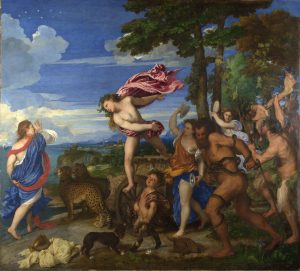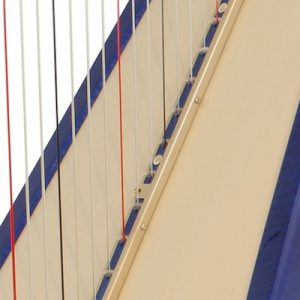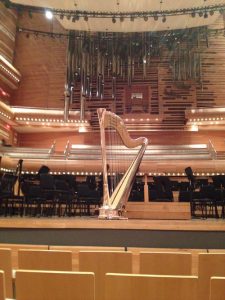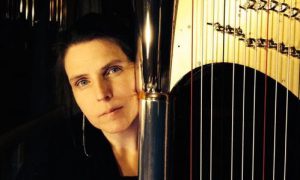Camac Blog
World Premiere of ‘Stellar Sonata’ by Caroline Lizotte: Paris, June 23rd 2019
Latest
May 23, 2019
Caroline Lizotte needs little introduction to harpists interested in the electroacoustic Blue Harp. We were proud to make her a mirrored-chrome Big Blue in 2015, and her extensive, award-winning body of compositions for harp already features the instrument: Danses Métales op. 47 for electric harp (in process for edition), or Stellae Saltantem op. 49, a duo for electroacoustic and acoustic harps. Other compositions also incorporate amplification and sound processing: most famously Concerto Techno op. 40 for harp, live techno and orchestra.
Supported by the Conseil des arts et des lettres du Québec, Caroline will soon give the world premiere of her new creation: Stellar Sonata opus 51 for electroacoustic harp. She will perform this at Camac Harps Paris, on Sunday, June 23rd (6PM).
“My chrome harp was a lot of work for Camac”, Caroline reflects. “It took several attempts to achieve the perfect, mirrored chrome finish, and another harp maker would have said no, or given up! But it had always been my dream to have a Camac electroacoustic harp, because I think they are the best on the market for what I expect of a such instrument. They allow for multiple audio and technical possibilities, their mechanism is solid and quiet, and their intonation is perfect. When my harp was finished, I promised Jakez François that I would write him a sonata for the instrument.”
Our chrome Big Blue is not the only back story. “In 2013, the Atlantic Harp Duo commissioned a work from me. Marta Power and Elizabeth Jaxon had a wonderful project inspired by ancient Greek mythology – about gods and mortals, about Ariadne’s story and life”, Caroline continues. “For their Ariadne Rediviva program, they wanted me to compose the final part, where Ariadne’s mortal life comes to an end. Her husband Bacchus (an immortal god), in order to celebrate their love, casts Ariadne’s nuptial crown into the firmament where it becomes a constellation – Corona Borealis, the Crown of Ariadne. Ariadne, loved by the gods, transported and immortalised in the celestial sphere. I decided that one harp would represent the gods (electroacoustic harp) and the other one would represent the mortals (acoustic harp), I titled the piece in Latin Stellae Saltantem, meaning “dancing stars”.
Stellae Saltantem is emotionally very strong. It was composed during my mother’s last days. From the moment I wrote the first bars of the piece, the ideas and the themes of a grande sonate were already forming in my mind. I had to finish the project for the Atlantic Harp Duo first, but once Stellae Saltantem had received its world premiere, I asked Marta and Elizabeth for permission to write a sonata that contained and developed some of the themes and characters present in Stellae Saltantem. This is why my new sonata is called Stellar Sonata.

Titian: Bacchus and Ariadne
Perhaps it’s partly because I am a harpist composer, and the harp has a close relationship with mythology, but I’m frequently inspired by this duality of the human and the divine, the terrestrial and the celestial. My new sonata explores and develops a few themes from Stellae Saltantem. The Minotaur reappears, in the first movement. Half-bull, half-man, this is another duality … the Minotaur is Ariadne’s half-brother, and the movement is full of strength, and describes the Minotaur’s internal struggle. The second movement has a ricercar form that expresses Ariadne’s lament, depicting when she is abandoned by Theseus on the island of Naxos. The third is about her beatitude, on marrying Bacchus and on her immortalisation into a constellation of stars.
However, all these subjects assume a new form. I haven’t written a sonata for harp before – I have written only one, for piano, called Rock Sonata op. 35 which I composed when I was about 17-18 years old. My harp works have always been constructed in other ways: Suite Galactique op. 39 is like a fantasy suite, Odyssée op. 37 is like an étude de concert, while La Madone has a song form. The technical structure of Stellar Sonata is quite different. I am fascinated by the inherent precision of sonata form, its principals of statement and development, its tonal relationships, recapitulations and clarity. I also wanted my harp sonata to have a certain familial link with my piano sonata: in terms of structure (3 movements), the appearance of specific themes between the movements, and even in the main title.
I particularly wanted to write this sonata for electroacoustic harp, because this instrument allows me to develop what would otherwise be impossible to do on an acoustic harp. I love the power of its amplified resonance, the length of its bass notes, and the flexibility in its sound processing. For example I use some distortion in the second movement, describing the rage of the abandoned Ariadne, and different kinds of delay in the third movement to give a spatial, celestial image.
 I also wanted to write this sonata to celebrate the rise of the electroacoustic harp in the 21st century. Sonata form is viewed as serious, traditional, so I thought it would be amazing to have a sonata specifically for electroacoustic harp. I hope this instrument will endure, become an official instrument itself, and have its own repertoire. If the harp world would ever programme a competition for electric/electroacoustic harp, I would hope that Stellar Sonata could be played in one of the stages …
I also wanted to write this sonata to celebrate the rise of the electroacoustic harp in the 21st century. Sonata form is viewed as serious, traditional, so I thought it would be amazing to have a sonata specifically for electroacoustic harp. I hope this instrument will endure, become an official instrument itself, and have its own repertoire. If the harp world would ever programme a competition for electric/electroacoustic harp, I would hope that Stellar Sonata could be played in one of the stages …
Beyond amplification for more power, the first movement has no interactions and manipulations with external electronic devices. These feature in the second and third movements. They serve the music, the text and images, the themes, the interpretation, rather than distracting from them. There is also a fun challenge articulating the electronic effects once you’ve nailed all the notes in your fingers!
While Stellar Sonata is structurally rigorous, its sound processing will have to be updated over time. Software and electronic devices are constantly changing. For instance, I will have Ableton Live and a pedal board for upcoming performances of my Stellar Sonata, but who knows what harpists will use twenty years from now? At the world premiere of Concerto Techno in 2003, the techno live act was performed on a german Schaltwerk sequencer station, and now we are mostly using Ableton Live …
Anyone interested in music technology has to consider what will endure, and what is a gimmick. Here, Art music can be very helpful. It has spent years perfecting certain structures, it contains centuries of savoir-faire. There are masterpieces in all established musical genres – classical music, hard rock, rock and roll … as more and more multimedia becomes available to us, maybe we also have to become more consciously selective. We can do so many things, we can travel so easily and discover so widely … our instruments can do so many things. It’s important that music continues to develop, but also that the expertise and the perfection achieved in the past isn’t lost in the discovery of new technologies. I wish that my Stellar Sonata will be guided by Ariadne’s magic thread, to escape from the Minotaur’s labyrinth.”



